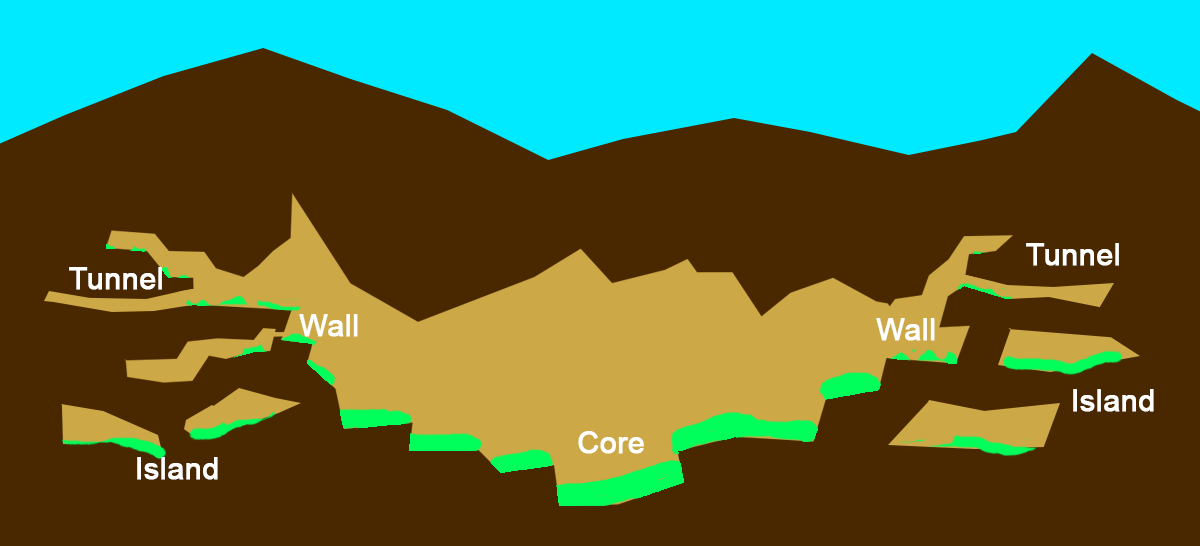Now, for my D&D-style world, there is an extremely large cave system hidden beneath a mountain. These caverns are illuminated by processes that are a bit too complicated to divulge, but in any case, it's in somewhat of an eternal twilight. The terrain is made up of various terraces surrounding large fields, resulting in a large inverted mountain, if you will. Also, do not ask how the mountain above is supported when there is a cavern of similar shape and equal size beneath it. There is lush vegetation down there, rich in silicon due to various large opal deposits and they also have an unusually high calorie count, for example, talmoss, which is the most abundant vegetation in the caverns and is three times as nutritious than your average grass, once again for complicated reasons. The most nutritious vegetation would be the blue-skinned pataya, a species of dragonfruit with twice the calories than that of a regular one. With this, the average calories of vegetation there would be 25 calories per ounce of plant matter. Since the area varies in plant matter concentration from temperate forest to tropical rainforest, any herbivorous or omnivorous creature would no doubt thrive there. The climate ranges between boreal in the upper reaches, temperate in the middle, and tropical in the lower regions. Animals are almost nonexistent, however. The main danger would be the opal deposits, as they form in such a way as to create spikes, meaning one wrong step would mean death. Also, rarely, strange superstorms form. These thunderstorms are massively deadly, as the lightning created by it is greatly empowered by strange means. Once again, don't ask. Now, for dragons. For clarity, my dragons lay an average of 75 eggs, which hatch into larvae known as wyrms. However, due to the wyrms being highly territorial, and the fact that dragons abandon their young until they pupate, the amount that lives to pupate is 1-3. Wyrms are about a foot long at birth and 2 inches around, and at the stage of "adulthood", wyrms are 8 feet long and 4 feet around, with a sharply tapering end. When a "baby" dragon emerges from the cocoon, they are roughly the size of a shetland pony, being four feet long (not including the tail) and 2 feet tall, with a 5 foot long tail. While the size varies wildly for an adult, the average size is 12 feet tall, with a 21 foot long body and a 32 foot long tail. The dragons are usually lithe, unlike other dragons from fiction. They also use the standard hexapodal body type, with four legs and two wings. The mating ritual involves dragons from several groups congregating about every five years, where both sexes are "tested," if you will. Males are tested for strength, horn size, scale durability, and breath weapon strength. Females are tested for intelligence, "beauty" (let's be honest, dragon beauty standards would be wildly different from ours), and feather beauty (yes, dragons have both scales and feathers in this world). Once the ritual is complete and mating pairs are made, the gestation period is 18 months, the wyrm lifespan is 10-12 months, the pupation period is 4-5 months, the time it takes to reach sexual maturity is 22 years, and the loss of fertility is at 174 years. Since females mate about every 15 years, the amount of time before dragons become independent from their parents, females mate about 11-12 times in their lifetime. They are omnivorous, able to digest pretty much all forms of plant matter, about as intelligent as humans, if not slightly smarter or dumber, and utilize renaissance level technology and agriculture.
Now, why did I tell you all this about dragons and this cave system?
Well, a group of dragons, carrying with them a variety of crops and cattle, had decided to colonize the lush caverns about 3.5 million years ago, enough for major adaptation to occur, and I want to know how these dragons I have presented will adapt to these cave systems i.e. will these conditions make them lose or gain muscle mass over generations. Bonus points for what their society may look like. Also, will they take advantage of the high concentrations of silicon in their food, i.e. opalizing their horns, teeth, and claws?
Oh, and about the whole "3.5 million years ago" thing, it's being discussed in another question of mine.
BTW, here's a link to my chatroom if you're interested in the world.


